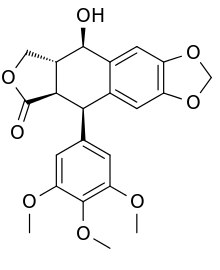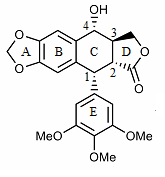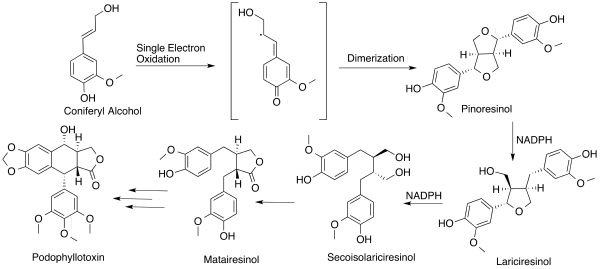Podophyllotoxin
 | |
| Clinical data | |
|---|---|
| Trade names | Condylox, Wartec, others |
| AHFS/Drugs.com | Monograph |
| MedlinePlus | a684055 |
| Pregnancy category |
|
| ATC code | |
| Pharmacokinetic data | |
| Biological half-life | 1.0 to 4.5 hours. |
| Identifiers | |
| |
| Synonyms | (5R,5aR,8aR,9R)-9-hydroxy-5-(3,4,5-trimethoxyphenyl)-5,8,8a,9-tetrahydrofuro[3',4':6,7]naphtho[2,3-d][1,3]dioxol-6(5aH)-one |
| CAS Number | |
| PubChem CID | |
| DrugBank | |
| ChemSpider | |
| UNII | |
| KEGG | |
| ChEBI | |
| ChEMBL | |
| ECHA InfoCard | 100.007.502 |
| Chemical and physical data | |
| Formula | C22H22O8 |
| Molar mass | 414.405 g/mol |
| 3D model (JSmol) | |
| |
| |
| | |
Podophyllotoxin (PPT), also known as podofilox, is a medical cream that is used to treat genital warts and molluscum contagiosum.[1] It is not recommended in HPV infections without external warts.[1] It can be applied either by a healthcare provider or the person themselves.[1]
It is a non-alkaloid toxin lignan extracted from the roots and rhizomes of Podophyllum species.[2] A less refined form known as podophyllum resin is also available, but has greater side effects.[3][4]
Podophyllotoxin was isolated in 1880.[5] In the United Kingdom the price for the NHS of 3.5 ml of medication is about 14.49 pounds.[6] In the United States the price of a course of treatment is more than 200 USD.[7]
Medical uses
Podophyllotoxin possesses a large number of medical applications and can be used as a cathartic, purgative, antiviral agent, vesicant, and antihelminthic. Additionally, podophyllotoxin and its derivatives are precursors for anti-tumor agents such as etoposide and teniposide.[8][9]
Adverse effects
The most common side effects near the application site are skin reactions, including burning, redness, pain, itching, swelling.[10] Application can be immediately followed by burning or itching. Small sores, itching and peeling skin can also follow.[11]
Neither podophyllin resin nor podophyllotoxin lotions or gels are used during pregnancy because these medications can be harmful to the fetus.
Overdose and toxicity
While podophyllin, the herbal extract from which podophyllotoxin is derived, can cause enteritis and potentially fatal CNS depression, podophyllotoxin has been shown to be safe, with minimal toxicity even in large doses.[12]
Mechanism of action
Podophyllotoxin destabilizes microtubules.[13][14] In contrast, some of its derivatives display binding activity to the enzyme topoisomerase II during the late S and early G2 stage. For instance, etoposide binds and stabilizes the temporary DNA break caused by the enzyme, disrupts the reparation of the break through which the double-stranded DNA passes, and consequently stops DNA unwinding and replication.[15] Mutants resistant to either podophyllotoxin, or to its topoisomerase II inhibitory derivatives such as etoposide (VP-16), have been described in Chinese hamster cells.[16][17] The mutually exclusive cross-resistance patterns of these mutants provide a highly specific mean to distinguish the two kinds of podophyllotoxin derivatives.[17][18] Mutant Chinese hamster cells resistant to podophyllotoxin are affected in a protein P1 that was later identified as the mammalian HSP60 or chaperonin protein.[19][20][21]
Chemistry
Structural characteristic
The structure of podophyllotoxin was first elucidated in the 1930s.[22] Podophyllotoxin bears four consecutive chiral centers, labelled C-1 through C-4 in the following image. The molecule also contains four almost planar fused rings. The podophyllotoxin molecule includes a number of oxygen containing functional groups: an alcohol, a lactone, three methoxy groups, and an acetal.[23]

Derivatives of podophyllotoxin are synthesized as properties of the rings and carbon 1 through 4 are diversified. For example, ring A is not essential to antimitotic activity. Aromatization of ring C leads to loss of activity, possibly from ring E no longer being placed on the axial position. In addition, the stereochemistry at C-2 and C-3 configures a trans-lactone, which has more activity than the cis counterpart. Chirality at C-1 is also important as it implies an axial position for ring E.[23]
Biosynthesis
The biosynthetic route of podophyllotoxin was not completely eludicidated for many years; however, in September 2015, the identity of the six missing enzymes in podophyllotoxin biosynthesis were reported for the first time.[24] Several prior studies have suggested a common pathway starting from coniferyl alcohol being converted to (+)-pinoresinol in the presence of a one-electron oxidant [8] through dimerization of stereospecific radical intermediate. Pinoresinol is subsequently reduced in the presence of co-factor NADPH to first lariciresinol, and ultimately secoisolariciresinol. Lactonization on secoisolariciresinol gives rise to matairesinol. Secoisolariciresinol is assumed to be converted to yatein through appropriate quinomethane intermediates,[8] leading to podophyllotoxin.

A sequence of enzymes involved has been reported to be dirigent protein (DIR), to convert coniferyl alcohol to (+)-pinocresol, which is converted by pinocresol-lariciresinol reductase (PLR) to (-)-secoisolariciresinol, which is converted by sericoisolariciresinol dehydrogenase (SDH) to (-)-matairesinol, which is converted by CYP719A23 to (-)-pluviatolide, which is likely converted by Phex13114 (OMT1) to (-)-yatein, which is converted by Phex30848 (2-ODD) to (-)-deoxypodophyllotoxin.[24] Though not proceeding through the last step of producing podophyllotoxin itself, a combination of six genes from the mayapple enabled production of the etoposide aglycone in tobacco plants.[24]
Natural abundance
It is present at concentrations of 0.3 to 1.0% by mass in the rhizome of American Mayapple (Podophyllum peltatum).[15][25] Another common source of podophyllotoxin is the rhizomes of Sinopodophyllum hexandrum Royle (Berberidaceae).
It is biosynthesized from two molecules of coniferyl alcohol by phenolic oxidative coupling and a series of oxidations, reductions and methylations.[15]
References
- 1 2 3 "Podofilox". The American Society of Health-System Pharmacists. Retrieved 8 December 2016.
- ↑ Xu, H; Lv, M; Tian, X (2009). "A review on hemisynthesis, biosynthesis, biological activities, mode of action, and structure-activity relationship of podophyllotoxins: 2003-2007.". Current Medicinal Chemistry. 16 (3): 327–349. PMID 19149581. doi:10.2174/092986709787002682.
- ↑ "Podophyllum Resin". The American Society of Health-System Pharmacists. Retrieved 8 December 2016.
- ↑ WHO Model Formulary 2008 (PDF). World Health Organization. 2009. p. 307. ISBN 9789241547659. Retrieved 8 December 2016.
- ↑ Cragg, Gordon M.; Kingston, David G. I.; Newman, David J. (2011). Anticancer Agents from Natural Products, Second Edition (2 ed.). CRC Press. p. 97. ISBN 9781439813836.
- ↑ British national formulary : BNF 69 (69 ed.). British Medical Association. 2015. p. 826. ISBN 9780857111562.
- ↑ Hamilton, Richart (2015). Tarascon Pocket Pharmacopoeia 2015 Deluxe Lab-Coat Edition. Jones & Bartlett Learning. p. 185. ISBN 9781284057560.
- 1 2 3 Gordaliza M, García PA, del Corral JM, Castro MA, Gómez-Zurita MA (2004). "Podophyllotoxin: distribution, sources, applications and new cytotoxic derivatives". Toxicon. 44 (4): 441–59. PMID 15302526. doi:10.1016/j.toxicon.2004.05.008.
- ↑ Damayanthi Y, Lown JW (June 1998). "Podophyllotoxins: current status and recent developments". Curr. Med. Chem. 5 (3): 205–52. PMID 9562603.
- ↑ Longstaff E, von Krogh G (April 2001). "Condyloma eradication: self-therapy with 0.15-0.5% podophyllotoxin versus 20-25% podophyllin preparations--an integrated safety assessment". Regul. Toxicol. Pharmacol. 33 (2): 117–37. PMID 11350195. doi:10.1006/rtph.2000.1446.
- ↑ "PRODUCT INFORMATION WARTEC® SOLUTION" (PDF). GlaxoSmithKline Australia Pty Ltd. Retrieved 6 January 2013.
- ↑ von Krogh G, Longstaff E (December 2001). "Podophyllin office therapy against condyloma should be abandoned" (Registration required). Sex Transm Infect. 77 (6): 409–12. PMC 1744412
 . PMID 11714936. doi:10.1136/sti.77.6.409.
. PMID 11714936. doi:10.1136/sti.77.6.409. - ↑ Hamidreza, Ardalani,; Amir, Avan,; Majid, Ghayour-Mobarhan, (2017-06-01). "Podophyllotoxin: a novel potential natural anticancer agent". Avicenna Journal of Phytomedicine. 7 (4). ISSN 2228-7930. doi:10.22038/ajp.2017.8779.
- ↑ Gordaliza, M; Castro, MA; del Corral, JM; Feliciano, AS (December 2000). "Antitumor properties of podophyllotoxin and related compounds.". Current pharmaceutical design. 6 (18): 1811–39. PMID 11102564. doi:10.2174/1381612003398582.
- 1 2 3 Canel, C; Moraes, RM; Dayan, FE; Ferreira, D (2000). "Molecules of Interest: Podophyllotoxin". Phytochemistry. 54 (2): 115–120. doi:10.1016/s0031-9422(00)00094-7.
- ↑ Gupta, R.S.; Ho, T.K.W.; Moffat, M.R.K.; Gupta, R. (1982). "Podophyllotoxin-resistant mutants of Chinese hamster ovary cells. Alteration in a microtubule-associated protein". J. Biol. Chem. 257: 1071–1078.
- 1 2 Gupta, R.S. (1983). "Genetic, biochemical and cross-resistance studies with mutants of Chinese hamster ovary cells resistant to the anticancer drugs VM-26 and VP16-213". Cancer Res. 43: 1568–1574.
- ↑ Gupta, R.S. (1983). "Podophyllotoxin resistant mutants of Chinese hamster ovary cells: Cross resistance studies with various microtubule inhibitors and podophyllotoxin analogs". Cancer Res. 43: 505–512.
- ↑ Picketts, D.J.; Mayanil, C.S.K.; Gupta, R.S. (1989). "Molecular cloning of a Chinese hamster mitochondrial protein related to the "chaperonin" family of bacterial and plant proteins". J. Biol. Chem. 264: 12001–12008.
- ↑ Jindal, S.; Dudani, A.K.; Singh, B.; Harley, C.B.; Gupta, R.S (1989). "Primary structure of a human mitochondrial protein homologous to the bacterial and plant chaperonins and to the 65 kDa mycobacterial antigen". Mol. Cell. Biol. 9: 2279–2283. doi:10.1128/mcb.9.5.2279.
- ↑ Anthony J. Trevor, Bertram G. Katzung, Marieke Kruidering-Hall, Susan B. Masters. Chapter 54: Cancer Chemotherapy. Katzung & Trevor's Pharmacology: Examination & Board Review, 10th edition.
- ↑ Borsche, W.; Niemann J. (1932). "Über Podophyllin". Justus Liebigs Ann. Chem. 494: 126–142. doi:10.1002/jlac.19324940113.
- 1 2 You, Y (2005). "Podophyllotoxin derivatives: current synthetic approaches for new anticancer agents.". Current Pharmaceutical Design. 11 (13): 1695–1717. PMID 15892669. doi:10.2174/1381612053764724.
- 1 2 3 Lau, Warren; Sattely, Elizabeth S. "Six enzymes from the mayapple that complete the biosynthetic pathway to the etoposide aglycone". Science. 349 (6253): 1224–1228. PMID 26359402. doi:10.1126/science.aac7202.
- ↑ J. L. Hartwell; A. W. Schrecker (1951). "Components of Podophyllin. V. The Constitution of Podophyllotoxin". Journal of the American Chemical Society. 73 (6): 2909–2916. doi:10.1021/ja01150a143.
Further reading
- Kelly M; Hartwell J. L. (1954). "The biological effects and the chemical composition of podophyllin: a review". Journal of the National Cancer Institute. 14 (4): 967–1010. PMID 13233838.
- J. L. Hartwell; A. W. Schrecker (1951). "Components of Podophyllin. V. The Constitution of Podophyllotoxin". Journal of the American Chemical Society. 73 (6): 2909–2916. doi:10.1021/ja01150a143.